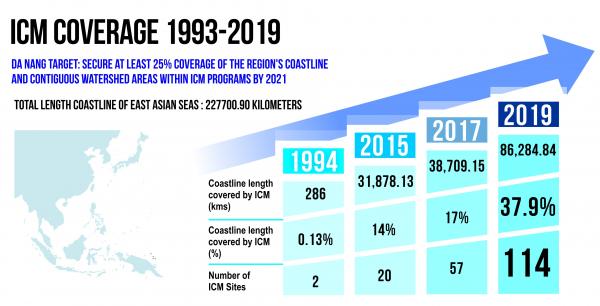At 39.7%, East Asian Seas surpasses ICM targets ahead of schedule
Friday, 14 August 2020

At the 12th East Asian Seas Partnership Council Meeting held recently, Partnerships in Environmental Management for the Seas of East Asia (PEMSEA) reported that it has surpassed its integrated coastal management (ICM) coverage target of 25% throughout the region ahead of schedule. As of December 2019, ICM coverage of the region’s coastline is now estimated at 37.9%, achieved well before the 2021 deadline.
ICM is a globally recognised approach on coastal governance to promote coastal sustainable development. It promotes inclusive, science-based and integrated spatial management of human activities in the coasts and ocean. This integrated approach helps local governments to achieve social and economic development targets in a number of areas—pollution reduction and waste management; food security and livelihood management; water use and supply management; habitat protection, restoration and management; and natural and man-made hazard prevention and management.
The 25% coverage of the region’s coastline and contiguous watershed areas through ICM programs by 2021 was agreed upon in the 5th East Asian Seas Ministerial Declaration or the Da Nang Compact. Eleven partner countries, namely Cambodia, China, Indonesia, Japan, Lao PDR, Philippines, RO Korea, Singapore, Timor-Leste, Thailand, and Viet Nam reported on their respective initiatives to implement their ICM programs at both the national and local levels. Their efforts are in line with the execution of the 2018-2022 Sustainable Development Strategy for the Seas of East Asia (SDS-SEA) Implementation Plan.
Scaling up ICM aims to: increase the areal extent and resilience of ecosystems in selected priority sites of the 11 partner countries; replicate good practices in the application of ICM tools to new sites; mobilize technical and investment support to scale up ICM implementation on the ground; implement certification programs for local governments, universities and ICM professionals; and catalyze public and private investments and participation in scaling up the implementation of ICM programs
Measurement of the region’s ICM coverage spans the period from 1993 to 2019. In 1994, there were only two ICM sites, with 286 kms. (or 0.13%) of coastline length covered by ICM. By the end of 2019, there were 114 ICM sites, covering 86,284 kms. of coastline.
PEMSEA’s focus in the remaining two years of the SDS-SEA’s implementation is to ensure that each country fulfills its own targets and to keep the progress of their ICM activities on track. More importantly, it is critical that the countries also measure the effectiveness and impacts of their ICM programs over the next two years, as well as validate the coastline coverage that was reported in 2019.



